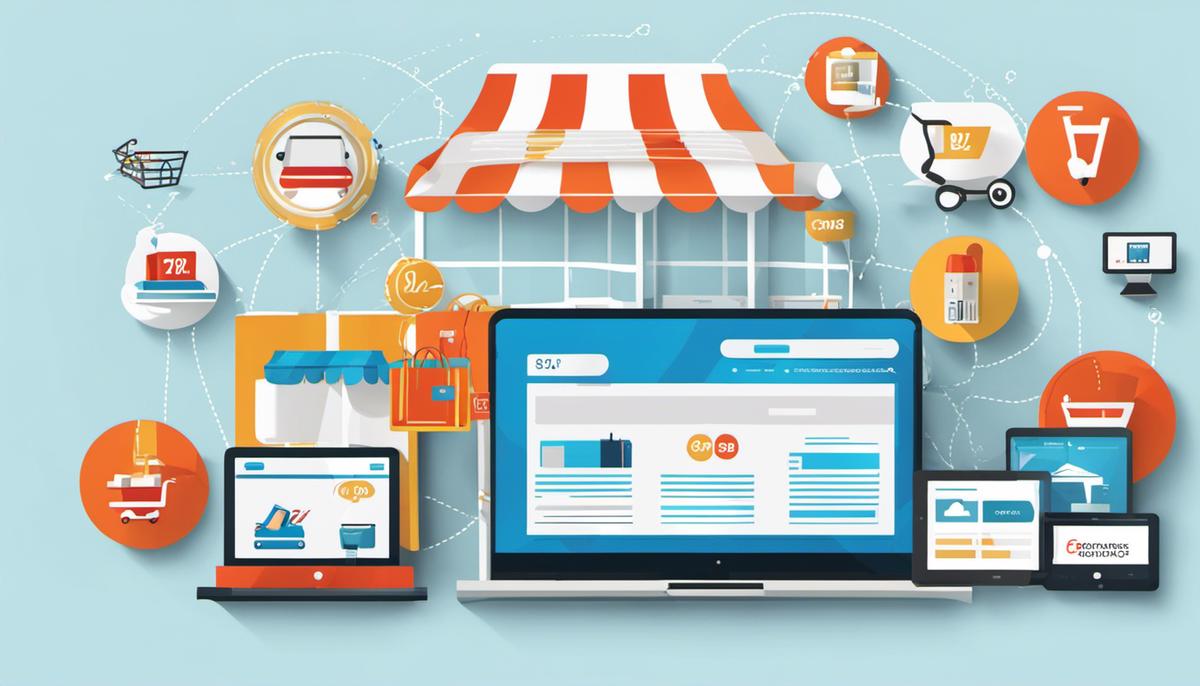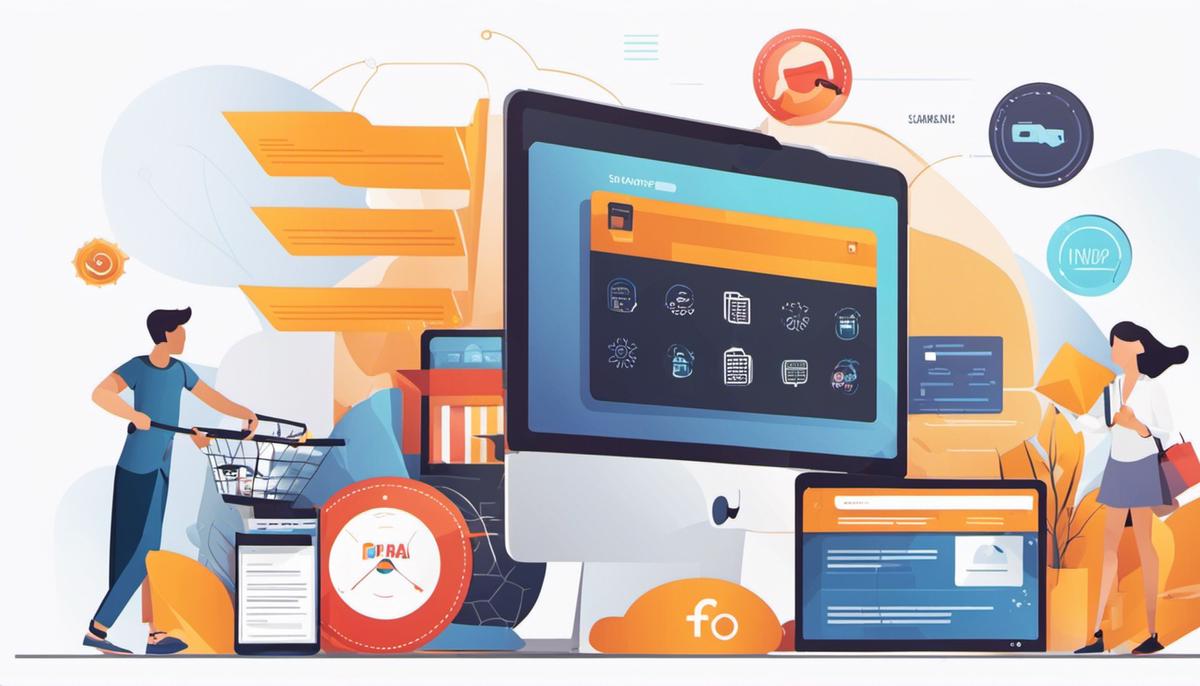As we navigate the Digital Era, the landscape of ecommerce is transforming rapidly, solidifying its place in our everyday lives. This complex ecosystem blends various elements such as market trends, consumer behavior, competitive analyses and innovative technologies. It’s imperative for businesses and customers alike to understand these dynamics to optimize strategies and enhance user experiences. This piece aims to provide a deep dive into the ecommerce universe, by studying current innovative ecommerce strategies like social commerce, mobile optimization and data-driven personalization, delving into user experience design and data optimization techniques, and exploring modern ecommerce marketing and growth hacking strategies.
Understanding the Ecommerce Landscape
Cracking the Code to E-commerce Success: A Comprehensive Understanding of the Landscape
In the ever-developing age of digital technology, there’s no denying that e-commerce has revolutionized the landscape of traditional business. As forward-thinking entrepreneurs, grasping the significance of understanding the ecommerce landscape is a step that cannot be ignored. It’s like playing a game of chess; to be victorious, understanding the entire board – the moves, the strategies, and even the opponent – is paramount.
The global e-commerce market, cherished for its endless possibilities and limitless boundaries, has opened channels for businesses worldwide to reach customers they otherwise wouldn’t. Having a comprehensive understanding of the ecommerce landscape not only aids in forming marketing and sales plans but also gives a competitive edge when analytically emerging trends and consumer behaviors.
Grasping the Pulse of Consumer Behaviour
With the advances in technology, consumer behavior has rapidly evolved. Gadgets and the internet have transformed their buying journey, making it both more complex and exceedingly demanding. To succeed, businesses need to anticipate needs, meet elevated expectations, and deliver exceptional customer experiences. Perception is key; understanding where, when, and what consumers are likely to purchase can significantly boost profit margins and help businesses stay ahead.
Harnessing the Power of Trends and Technologies
Beyond the consumers, it is crucial to understand the ecommerce landscape in the broader sense. This includes being familiar with new trends, technologies, and techniques that drive the sector. Mobile commerce, drop shipping, voice shopping, augmented reality, and artificial intelligence are just the tip of the iceberg. Businesses that adeptly leverage these advancements and mold their strategies accordingly are set to reap rewards.
Leveraging Global Reach
Ecommerce has made it significantly easier for businesses to break geographical barriers. It is no longer about the immediate neighborhood or local city. The entire world is up for grabs. By understanding international markets, interpreting demographics, and accommodating cultural nuances into the business strategy, businesses can unlock the enormous potential of global outreach.
Cultivating Healthy Competition
In an open market, competition is inevitable and healthy, and ecommerce is no exception. An understanding of the competitive landscape helps businesses to assess their position, determine areas of weakness, and plan strategies to outperform competitors. It could involve price adjustments, customer service improvements, or even comprehensive business operations overhaul.
To Conclude
In essence, understanding the ecommerce landscape is much like constructing a building. As entrepreneurs, we have the challenge and the opportunity to create a solid foundation that will withstand the test of time. The blueprint for this robust foundation is a comprehensive understanding of the ecommerce landscape, a dynamic tool that empowers businesses, enhances decision-making, and fosters success.
But remember, Rome wasn’t built in a day, neither is e-commerce success. It requires patience, constant learning, iteration, and most crucially, a persistent entrepreneurial spirit.

Innovative Ecommerce Strategies
Unleashing Ecommerce Innovation: Revolutionary Tactics for Market Disruption
In our ever-evolving world of business, one sector distinctly stands out for its incredible growth and potential for disruption—ecommerce. With the breakneck pace of technological advancements paired with shifting consumer priorities, this sector provides immense opportunities to forge new paths in market disruption. Considering the groundwork already laid out, it’s time to delve into some unique and innovative ecommerce strategies that can truly upend the market.
-
Hyper-Personalization and Customization:
In an era where consumers relish personalized experiences, businesses capable of hyper-personalization stand at the forefront of ecommerce disruption. This revolves around the concept of understanding each customer’s preferences, shopping behavior, and engagement history. By deploying AI and data analytics tools, businesses can curate highly-targeted marketing campaigns, offer individualized product recommendations, and deliver customized shopping experiences. The aim is to make customers feel valued and enhance their brand loyalty.
-
Adoption of Augmented Reality (AR) & Virtual Reality (VR):
In the quest for creating immersive shopping experiences, AR and VR technology present unprecedented possibilities. With AR, brands can offer customers a ‘try before you buy’ experience, prompting higher engagement and conversions. On the other hand, VR can create an entire digital showroom, allowing customers to navigate through products just as they would in a physical store. While these technologies are still relatively nascent, early adoption can offer a tremendous competitive advantage.
-
Expanding the Marketplace Model:
Hosting businesses on a single platform brings vast options to consumers and allows entities to leverage a ready-made customer base. Adding to the traditional marketplace model, businesses can introduce services that match their product offerings. For instance, a furniture ecommerce store could introduce interior design consultation services, crafting a one-stop solution for the customers. This innovative approach expands consumer choice, promotes brand stickiness, and fosters ways to disrupt the market.
-
Integration of Blockchain Technology:
As a trailblazer of the digital economy, blockchain promises to revamp ecommerce by enhancing security, reducing costs, and ensuring transparency. By eliminating middlemen, businesses can ensure direct transactions between buyers and sellers, fostering greater trust. Blockchain’s potential in tracking product origin can significantly reduce counterfeiting, a persistent issue in the ecommerce industry. This adoption redefines the industry’s future and sets the stage for substantial market disruption.
-
Transition Towards Sustainable and Conscious Commerce:
Gone are the days when price and quality solely determined purchase decisions. The modern consumer holds businesses accountable for their environmental footprint and societal impact. Ecommerce entities must consider embedding sustainability into their business models, ranging from eco-friendly packaging to supporting fair trade practices. This shift not only helps preserve our planet but also resonates deeply with consumers, creating a significant competitive edge.
The ecommerce landscape is ripe for disruption on a scale that’s previously unimagined. Let’s challenge the traditional molds, explore uncharted territories, and most importantly, embrace innovation and technology. Market dominance belongs to those unafraid to dare, to adapt, and to disrupt.

Optimizing User Experience
Accelerating Business with User-Centered Design
Optimizing user experience in ecommerce is more than a goal—it is an essential strategy for success. A well-designed and enjoyable user experience intersects with every facet of ecommerce, influencing purchasing decisions, customer loyalty, and the overall growth of the business. User-centric design is, indeed, the game-changer in the ferociously competitive digital marketplace.
Nurturing the Purchasing Journey
Central to an online business’ success is how efficiently the site navigates its users through the buying process. The less friction there is, the higher the chance a visitor will make a purchase. For usability, simplicity is key: those online journeys that seamlessly glide from search to payment stages outperform their competitors. Visual aspects, page responsiveness, and intuitive interfaces possess the power to elevate conversions significantly.
Reaping Benefits of Data Analytics and AI
Implementing comprehensive data analytics and AI tools in ecommerce enhances user experiences dramatically. By examining user behavior, preferences, and feedback, companies can obtain invaluable insights. These insights subsequently drive the refinement of UX design, product offerings, and marketing efforts. Artificial Intelligence ramps up personalization, offering tailored suggestions based upon past purchases, browsing history, and consumer profiles.
Capitalizing on Mobile Optimization
As m-commerce continues to rise, mobile optimization is no longer optional—it is indispensable. Ensuring a website is mobile-friendly with fast page load times and simplified forms increases the likelihood of capturing and retaining mobile user interest. Moreover, optimizing for search engine algorithms plays a starring role as they favor mobile-first indexing.
Boosting Brand Loyalty with Exemplary Customer Service
Incorporating innovative methods like chatbots and AI-driven customer service can ameliorate user experience considerably. By providing quick, 24/7 support and resolving issues promptly, businesses can build a strong rapport with users. This commitment to exemplary customer service fosters trust and loyalty, leading to increased customer retention and lifetime value.
Capitalizing on Social Commerce
Social media platforms have transformed into influential sales channels, leading to the explosion of social commerce. Providing users with a smooth and easy shopping experience right within their beloved social platforms significantly boosts business reach and conversion rates.
Maintain an Edge with Constant Innovation
The fast-paced world of ecommerce drives the necessity for continuous innovation. The ability to adapt to changes and implement fresh concepts can set a company apart from the competition. The implementation of aspects like voice search, drone delivery, and AI personal shoppers represents just a fraction of the potential advancements that could redefine the future of user experience in ecommerce.
In conclusion, optimizing user experience is integral to the thriving existence of any ecommerce endeavour. It is not merely about keeping up with industry standards—it’s about exceeding them. It’s about creating an online environment that not only meets customers’ needs but also delights them at every touchpoint. Ultimately, investing in user experience isn’t a business choice – it’s a business necessity.

Leveraging Data Analysis
Advancing Ecommerce Performance Through Predictive Analytics
Harness the power of predictive analytics to revolutionize your ecommerce performance. Predictive analytics refers to the usage of statistical analysis, machine learning, and data mining to predict future events. This futuristic approach allows ecommerce platforms to delve deep into customer data and glean insightful trends that can drive decision-making.
Consider this – according to Adobe, 76% of purchase decisions are influenced by predictive analytics. In the world of ecommerce, those numbers can have transformative results, transforming site visitors into loyal customers. Implementing predictive analytics into your strategy can streamline operations, boost conversion rates, and significantly increase revenue.
Empowering Demand Forecasting
Demand forecasting is an integral part of ecommerce operations. Predictive analytics revolutionizes this age-old system, allowing businesses to make highly accurate demand forecasts. Through assessing historical data and factoring in variables such as promotional activities, seasonal trends, and even the weather, predictive analytics provides businesses with crucial insights they need to make more accurate stocking decisions and effectively manage their inventory.
Staying a Step Ahead with Predictive Pricing
The impact of predictive analytics is not confined to inventory management. Dynamic pricing is another area where this technology can give your ecommerce platform the upper hand. Dynamic pricing adjusts prices based on factors such as demand, competitor pricing, and time of day. Predictive analytics can optimize these price adjustments, maintaining competitiveness and maximizing profit.
Refining Site Navigation with Data-Driven Insights
Finally, predictive analytics can refine the way consumers navigate your ecommerce platform. With predictive analytics, businesses can capitalize on heatmap analysis, which displays where on your site users mouse over, click, or scroll. This essential tool informs your design choices, allowing you to position key products or services in the most visible site areas, enhancing user experience and driving conversions.
Embrace the future today by introducing predictive analytics. As an entrepreneur, you understand the importance of staying ahead of the curve. This deep-dive into customer behavior can give your ecommerce platform the kickstart it needs to compete in today’s saturated market. Afterall, understanding your customer is the ultimate business strategy, and predictive analytics provides the key to unlocking a comprehensive understanding like never before.

Ecommerce Marketing & Growth Hacking
Exploiting the Might of Micro-Moments
In this fast-paced digital era, winning over the ecommerce sector requires not only an understanding of consumer behavior, trends, and technologies, but also an appreciation of fleeting opportunities. Seizing these “micro-moments”, or those quick instances when consumers reach for their devices to learn, do, discover, watch, or buy something, provides bricks for building a swift growth strategy. Targeting such micro-moments results in winning and keeping customers atop the buying funnel.
Capitalizing on Independent Brands and Niche Markets
The vast reach of the ecommerce market affords it a wide-ranging motion. This offers opportunities to serve not only mass-market products but also niche segments. Catering to these niche market segments can resultantly induce colossal growth. Independent brands bring innovation and exclusivity to the table, exactly what a discerning modern audience craves. By partnering with these brands, ecommerce platforms can appeal to a particular consumer base and significantly boost sales.
Prioritizing Real-Time Engagement and Interaction
The digital consumer is always connected, and they expect the companies they engage with to be equally responsive. Real-time engagement via social media channels, messengers, and live chats can ensure ‘always-on’ interaction and helps to resolve customer queries instantly. Regular updates and flash sales alerts can also keep customers connected to the platform, leading to repeat purchases and thereby driving growth.
Introducing Gamification in ecommerce
Fundamentally, it’s human nature to be competitive and engage in games. The integration of gamification into ecommerce platforms can serve a dual-purpose: entertaining the customer while nudging them towards making purchases. Loyalty points, rewards, and contests can enhance customer engagement, stimulate viral growth, and increase user generated content – invaluable to both rapid growth and customer retention.
Strategically Implementing Dynamic Retargeting
Similar to grasping consumer behavior, dynamic retargeting allows brands to keep themselves at the forefront of consumers’ minds. By utilizing user data to display tailored ads for previously browsed or related products on additional digital platforms, brands can garner better conversion rates. Ecommerce platforms can also aim to recover abandoned carts through timely and personalized retargeting strategies.
Taking Advantage of Voice and Visual Commerce
With the mass-adoption of smart speakers and the AI augmentation in smartphones, voice shopping has emerged as a fast and convenient option. It offers users an added layer of simplicity, speed, and freedom of mobility. Visual commerce, on the other hand, uses imagery not just to display a product but to sell the lifestyle it promotes – thereby subtly pushing the user towards making purchases.
Unlocking the Potential of Influencer Marketing
Scientifically, potential customers are more likely to buy a product when someone they admire recommends it. Utilizing influencers to advertise products can lead to an edge in the highly competitive ecommerce market. Besides reaching a more extensive network, influencers also offer the benefit of increased trust over brands.
The ecommerce market is no longer about merely buying and selling goods/services online. It’s an ever-evolving industry that unprecedentedly paves the way for innovation. Marketers need to stay one step ahead to ride the wave of swift growth and success.

Taking all these aspects into account, effective ecommerce isn’t just about setting up an online store. Understanding market trends, utilizing innovative strategies, optimizing user experience, leveraging data analysis, and implementing effective ecommerce marketing techniques are instrumental tools. The successful implementation of these elements can lead to higher customer satisfaction, business growth, and eventually unmatched competitive edge. As the advances of digital transformation continue to push the boundaries, it’s important that we stay adept with these changes and continue to reshape the ecommerce landscape that we know today, for the future that tomorrow could bring.
Writio: Transforming the way you create content! This article was written by Writio.







